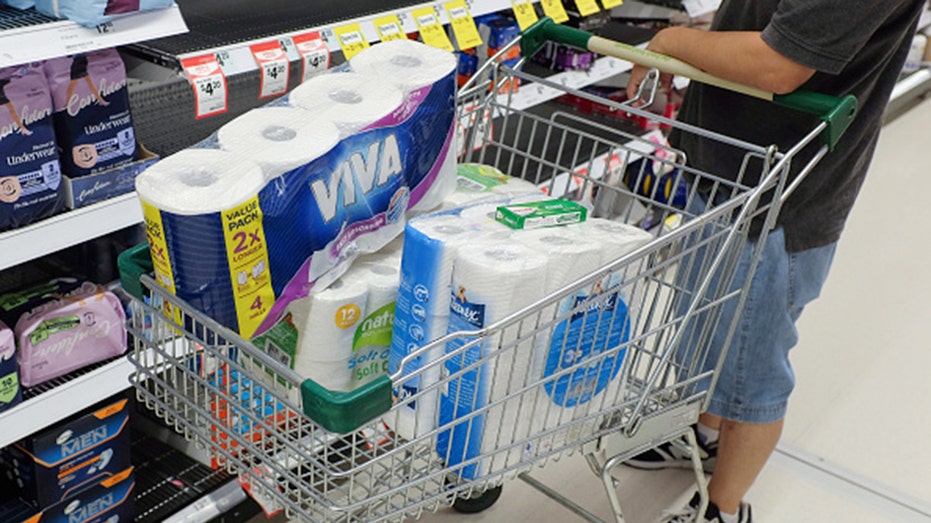Americans have too much toilet paper. It is catching up to companies.
Tissue sales fall to below pre-pandemic levels as consumers work through their stockpiles
After a year in which toilet-tissue shortages left consumers scrambling for squares, sales are plummeting to below pre-pandemic levels.
Bath-tissue sales in January fell more than 4% from the same period a year earlier, before the spread of Covid-19 spurred Americans to load up on staples from toilet paper to sanitary wipes, according to figures from NielsenIQ. The decline, which comes even though legions of Americans continue to work and attend school from home, indicates last year's stockpiling is starting to have an effect on sales.
KIMBERLY-CLARK SAYS COTTONELLE, SCOTT TOILET PAPER PRICE HIKES COMING
"You never knew when you weren't going to be able to get it, so every time we went out we got some," said Marjorie Greenburgh, 62 years old, of New Rochelle, N.Y. "They just kept amassing."
Ms. Greenburgh still has 54 rolls, stored in various places throughout her home: in a guest room, the back of a linen closet, the laundry room in the basement. "I'm not planning on buying for a while," she said.
Demand for toilet paper shot up in the outbreak's initial weeks, doubling in the second week of March, and remained elevated throughout most of 2020. Americans spent more than $11 billion on toilet paper last year, up from $9 billion in a typical year, according to NielsenIQ.

A customer holds a shopping cart filled with toilet and kitchen paper at a supermarket in Sydney, Australia, on Wednesday, March 4, 2020. (Brendon Thorne/Bloomberg via Getty Images)
A rush on other household staples, from disinfecting wipes to paper towels, led to equally or more-severe shortages of those products. But none triggered consumers' anxieties as much as toilet paper.
In the pandemic's early days the internet was flooded with memes and jokes about toilet-tissue scarcity; many people registered serious panic. Procter & Gamble Co. added a prerecorded message to Charmin's toll-free line specifically for people hunting for toilet paper. Walmart Inc. Chief Executive Doug McMillon, on a "Today Show" appearance in April 2020, urged consumers to stop buying so much toilet paper.
GET FOX BUSINESS ON THE GO BY CLICKING HERE
"Tissue is just one of those things that has really demonstrated the impact of the pandemic more than others," said analyst Jonathan Rager of Fastmarkets RISI, an analytics firm specializing in the pulp and paper industry.
P&G and Kimberly-Clark Corp., which makes Cottonelle and Scott toilet paper, declined to comment on whether either company has adjusted toilet-paper manufacturing as sales cool.
A combination of increased use and stockpiling led to toilet-paper shortages, executives said at the time. Tissue used in office bathrooms and public restrooms is generally built at different plants, and funneled through a different supply chain, than toilet paper sold to consumers at stores. So the sudden drop in demand for public-restroom quality tissue didn't lead to a supply surplus of the higher-end stuff.
CLICK HERE TO READ MORE ON FOX BUSINESS
Meantime, whereas companies were able to more quickly increase capacity for cleaning products, hand sanitizer and other in-demand items, doing so for toilet paper was less feasible given that making toilet paper in bulk requires a four-story-tall machine that costs billions of dollars and takes months to build.
Sales of toilet paper are down 0.2% for the 52-week period ended April 3. In January, according to NielsenIQ, toilet paper sales were down 4.3% from January 2020, when the pandemic had just reached the U.S. and before the World Health Organization declared Covid-19 a public-health emergency.
Sales of paper towels were up 10% in January compared with a year earlier while sales of household cleaners were 75% higher.
The declines have accelerated since then, with toilet-paper sales down about 14% in February and 33% in March, according to NielsenIQ. Those drops reflect comparisons to periods in which demand was soaring.
The country's papermaking mills, which were operating at 100% capacity for much of last year, are now running around 90% to 95% capacity, which is a more normal level, said Mr. Rager, the Fastmarkets analyst. Those mills also supply materials used for paper towels, napkins and tissues, products that have seen less-pronounced sales declines than toilet paper.
The expense and time involved in adding capacity to make consumer paper products, coupled with the fact that it is a segment defined by thin margins and demand that changes little over time, meant that capacity and supply chains changed little to accommodate pandemic-driven demand relative to other products.
Big toilet-paper makers maxed out capacity, and P&G restarted a piece of idled equipment. But there were no overhauls on the scale of efforts by Clorox Co., for example, to increase capacity for cleaning products or by Purell maker Gojo Industries Inc. to increase hand-sanitizer production.
